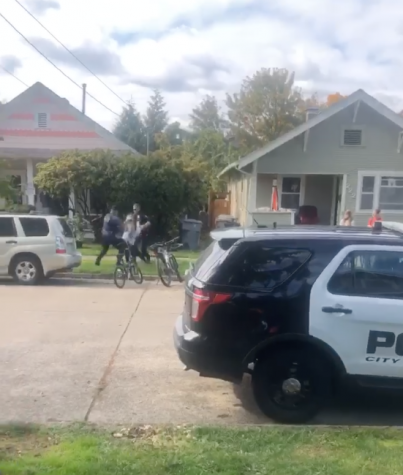Editorial: OSU mishandled communication regarding safety threats
March 4, 2018
Students, community members were confused, frustrated by university’s response to threatening social media posts
An ominous tweet from the university’s official Twitter account. A slightly less-vague, yet still unclear alert from officials over two hours later. Finally, the all-clear. The next day, an email sent out defending the university and calling for broader community involvement and reaction.
Confused what we’re talking about? So were over 32,000 Oregon State University students, staff, families and community members following university alerts that social media posts threatening violence against the OSU campus were being investigated.
To bring everyone up to speed, here is a quick recap of what took place Tuesday, Feb. 27:
Tuesday morning, a former OSU student named Christopher Strahan tweeted threats of violence towards OSU. The university was made aware of these tweets through SafeOregon.com, the Oregon State Police statewide tip line.
OSU subsequently tweeted this message at 12:52 a.m., “Our public safety officials are aware of recent concerning tweets and are investigating. As always, we encourage students and the Oregon State community to report any concerns to OSU Public Safety at 541-737-7000.”
An hour later, around 1:50 p.m., OSU students received an email alert repeating that Oregon State Police were investigating social media posts threatening violence at OSU’s campus.
Another email alert was sent out an hour later stating the individual believed to have authored the social media posts was in custody.
We were on campus while these events were taking place Tuesday. We received the university’s tweets and subsequent emails. We as students, however, did not feel safe or even slightly reassured by the university’s communication.
From reading OSU’s tweet and emails that day, no student was informed what these threats were. No student was made aware how the university was investigating. No student was even assured that their next class wouldn’t be the scene of a school shooting.
What we were assured of, however, is the presence of a monumental breakdown in communication from university administrators. This was apparent from the numerous calls for OSU to clarify their initial tweet and the clear outrage from students and family members who felt helpless in the situation. Without the context needed to fully understand the situation and potential danger they were facing, several students made the decision to leave class and avoid campus for rest of the day. Instead of stepping in to further clarify or reassure students they were not in immediate danger, the university chose to merely state they were investigating the social media posts many students had already seen.
In a time where school shootings are commonplace, we as students are looking to our administrators to assure us we are safe and our well-being is prioritized. It is clear in this case that the university and the administrators failed the students they are employed to serve.
Not only was the student body given inefficient information, but we were also accused as being part of the problem.
Another all-students email was sent the following day, authored by Vice President of University Relations and Marketing Steve Clark and Vice President of Finance and Administration Mike Green. In this email, Clark and Green outlined the events that took place the previous day and how the university responded.
However, instead of acknowledging the missteps from the university or the public’s response, the email called out the community. Clark and Green noted the threatening social media posts had been active since early Tuesday morning, yet the university was not informed of them until 12:02 p.m.
“As a community,” the email then stated, “we all must recognize that such a delay is problematic. We encourage all members of the OSU community–and the public–to immediately say something if you see something.”
Absent from that letter? The signature of Ed Ray, the OSU president. The signature of Suzanne Tannenbaum, the OSU director of Public Safety. The signature of Dan Larson, the interim vice provost of Student Affairs.
It is worth noting the university was notified of the threats through an anonymous tip made through the internet. They did not discover it themselves. The community did their part to be vigilant and say something when they saw something. At the time of these tweets Strahan had 19 Twitter followers.
It is the university’s obligation above all else to monitor and proactively seek out threats and danger to the campus community.
We know this individual has a criminal history relating to this type of behavior. We know software exists that can monitor social media threats. We know OSU employs professionals to keep the public safe. And yet, Tuesday was still a frightening and confusing day to students.
OSU needs to own up to the fact they failed their students in this situation.
The leaders of the university, starting from the top with President Ray, need to further consider how their communications are received and learn from this incident. We as students put our trust and faith in our university officials to keep us informed, educated and protected—and it’s time our administrators do just that.

























































































































